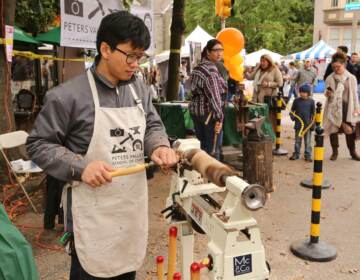Princeton University’s celebrates its newest outdoor art installation
Earlier in the semester, on a sticky 90-degree day on the Princeton University campus, the front lawn of the Princeton University Art Museum was cordoned off with chain-link fencing. A major sculptural project by the Starn Brothers was getting the finishing touches. One brother sat on a bistro chair, protected from the sun under a market awning, focused on his laptop. From outside the fence one could see an e-mail displaying a picture of the sculpture before him, “(Any) Body Oddly Propped,” under a blue sky with billowing clouds. The other brother was supervising the work as a videographer recorded it. Fans had gathered to watch Doug and Mike Starn, who were only present for a few of the installation days.
The identical twins have beards and shoulder-length hair with graying roots that frizzes in the humidity. Wearing mirrored aviator sunglasses atop their heads, gray T-shirts and faded jeans, they look like aging rock stars. In 2010 they rocked the art world with Big Bambu: You Can’t, You Don’t and You Won’t Stop on the roof of New York’s Metropolitan Museum.
Over 130 feet tall, the “habitable sculpture” had an elevated performance space, a double helix stair and labyrinth paths leading up to multiple lounging spaces 65 feet high. Among those who climbed it were then New York City Mayor Michael Bloomberg; the artists Martin Puryear and Francesco Clemente; and musicians Bono, Lou Reed and Paul McCartney, who went up barefoot.
In front of the Princeton University Art Museum, the seated brother closes his laptop and packs it into a backpack, then joins his twin who grins broadly at something the first brother says. They point upward and confer with a worker in a yellow safety vest. One brother has a camera with a big lens, the other is scrolling through his phone. One, like Spiderman, climbs to the top to inspect. Soon the bright orange ladder, yellow metal scaffolding and birch panel shipping crates would disappear and “(Any) Body” would be open for viewing.
The newly commissioned work, weighing nearly eight tons, is constructed of six 18-foot tall vividly colored glass panels – featuring a new glass-dyeing technique pioneered in Germany – and two cast bronze forms resembling tree limbs. It was designed by the Starns specifically for the site and continues the artists’ long-standing fascination with energy systems found in nature.
“The medium always chooses itself, through an exploration of the concepts and the way it will be shown or where it is going to be shown,” say the Starns in an e-mail, with no specification as to who it’s coming from – united they stand. “Stained glass has long been taking form for us in our minds.”
Related to Picasso’s late sculptures, in which the artist stood two flat images together, “(Any) Body” may also be read as the walls of an outdoor stained-glass chapel propped together, inviting the visitor to walk among the panels. The enlarged arboreal images send out branches that branch yet again and again.
“It was a challenge to develop some of the techniques that could meet our vision of how these images would translate into glass,” say the Starn brothers. “We came pretty close to it. The engineering was a completely different challenge, it is complicated in several ways.”
Born in Absecon, New Jersey, in 1961, Doug and Mike loved to draw as children. The Starn parents encouraged their children’s interest in art, taking them to the Philadelphia Museum of Art when Doug and Mike were 9. Robert Rauschenberg’s combines and Andy Warhol’s “Electric Chair” left a lasting impression.
Accepted to the esteemed School of the Boston Museum of Fine Arts with a shared portfolio, the brothers experimented on separate paths but learned their best work was what they produced together and earned MFAs in 1985. They gained international recognition at the 1987 Whitney Biennial.
There are a few things they don’t do together. Mike is married to Anne Pasternak, who in May was named director of the Brooklyn Museum; the couple has an adult daughter. Doug’s wife is Nancy Bressler, a fine-art printer and publisher, with whom he has teenaged children.
Trees are a major theme for the brothers. The Starns have described trees as a recording of light turned into carbon through photosynthesis — the transformation of light into dark physical matter – an architecture of inky black darkness, growing towards the source. “We want to combine… the inner cosmos of the mind, bringing in neuronal imagery,” they have said. Their stark silhouettes of intertwined branches, reminiscent of the veins and arteries of the human body, are present in (Any) Body.
Watching them at work, one definitely gets the sense of two brothers who love to play and climb trees. “People like us — and rock climbers — we don’t fit into the dead artist thing,” Doug Starn told the New York Times in 2010 when Big Bambu was dismantled. “Us and the climbers are part of the piece, part of the organism. We live in the piece. We need to enjoy what we make, and we need to enjoy ourselves while we’re making it.”
To celebrate the unveiling of (Any) Body Oddly Propped, artists Doug and Mike Starn will discuss their work with Princeton University Art Museum Director James Steward on Saturday, October 24, 4 p.m., McCosh 50, Princeton University campus. A reception in the art museum will follow.
______________________________________________________
The Artful Blogger is written by Ilene Dube and offers a look inside the art world of the greater Princeton area. Ilene Dube is an award-winning arts writer and editor, as well as an artist, curator and activist for the arts.
WHYY is your source for fact-based, in-depth journalism and information. As a nonprofit organization, we rely on financial support from readers like you. Please give today.









